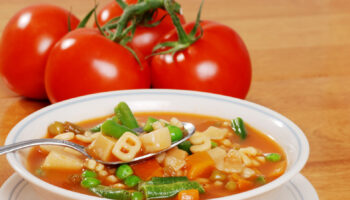Natalie Grebe
Most Americans are well-aware of the benefits of healthy eating. Posters in the doctor’s office, magazine covers, social media and television shows barrage us with information on what to eat and when to eat. Healthy eating can be difficult, especially for those with a limited palate, and it can be expensive. Through well-planned snack times, there are ways to introduce children to healthy foods. The benefits of this are more than great nutrition. In an article posted on Knowswhy.com, the author states, “If they (children) eat foods rich in vitamins and minerals, their immune system will be stronger. They will not suffer from illnesses and infection. Kids who eat healthy foods have sharper minds and high mental capacity. Proper nutrition and academic performance correlates with each other according to research.” When planning snacks teachers should remember to adhere to USDA meal guidelines.
Snack time is also an easy time to incorporate many themes taught in the classroom. Learning about vehicles? Make cars with apple slices and grapes cut in half for wheels. Learning about pumpkins? Instead of just baking the seeds, try pumpkin bread or muffins. Measurement and counting span across so many recipes, making it easy to teach math topics. Science is incorporated into baking and cooking as well.
Snack time can also be a wonderful opportunity to teach basic food preparation skills. Many families today are constantly on the go. Often rushing through meals to get to the next activity, parents rely on prepackaged foods. Parents also may not see meal time as a teachable moment. Proper use of kitchen utensils, stirring, cutting, scooping and measuring, among others, are necessary skills for children as they grow. While it may be more efficient for parents to prepare foods without involving the children, this leaves older children and teenagers unable to function independently. Snack time in programs for two-year-olds through school age are a great chance for teachers to help children achieve these skills.
Whether working with preschool or older school age, certain aspects of food preparation are a must:
- Handwashing before and after meal prep
- Working on a properly cleaned and sanitized surface
- Knowledge of children with food allergies
- Guidelines and expectations appropriate to the age
- Appropriate teacher supervision
Most children will be eager to help prepare a snack, but safety must be a priority. While it may be appropriate to oversee a ten-year-old operating a toaster, this is an appliance that would not be left within reach of a four-year-old. Teach all children that utensils and appliances are tools, not toys. The proper way to hold a knife, for example, must be adhered to always. If baking food in an oven, the teacher should handle putting the dish in and removing from the oven. However, use the opportunity to teach kids about preheating, following recommended cooking times and oven safety.
Rather than viewing snack as just a routine activity, use this part of the day to teach the value of healthy food choices, encourage more reluctant eaters to try a new food and teach basic kitchen skills that will benefit children as they grow. Below are suggestions for preparing healthier snacks for various age groups. For more recipes to make with children visit youtube.com for a large selection of videos on this topic.
Snack Ideas for Younger Children:
Fruit cups: Teacher washes and cuts fruit ahead of time. Place each fruit in a separate serving bowl. Put vanilla yogurt in a serving bowl. Add large cups and spoons to the workspace. Instruct children to put 1 or 2 spoons of each fruit into their cup. Add a scoop of vanilla yogurt to the top if preferred.
Snack Mix: Teacher places snack mix ingredients in serving bowls (think Cheerios, mini pretzel sticks, mini chocolate chips and rice cereal). Avoid nuts at this age. Place number cards at each bowl, so the child knows how much of each ingredient he/she can place in their cup.
Snack Ideas for Preschool-Kindergarten:
No Bake Cookies:
(recipe is for 4 servings, so you will want to adjust amounts)
- 8 whole-wheat graham cracker squares, finely ground
- ¼ cup raisins
- ¼ cup smooth natural peanut butter (use peanut butter substitute for children with allergies)
- 2 tablespoons plus 2 teaspoons honey
- 4 teaspoons unsweetened coconut (optional)
Preparation:
Combine ground whole-wheat graham crackers, raisins, peanut butter and honey in a small bowl. Pat into 8 cookies and press lightly in coconut.
In “11 Kids Snacks That Make Eating Fruits and Vegetables Fun” found on thedailymail.com, ideas for making Apple Turtles, Veggie Boats and Banana Bears, among others, are included.
Snack Ideas for School Age:
This is a great age to teach the difference between measuring cups used for dry and liquid measure. Teach the proper way to crack an egg and let the kids practice! Demonstrate using a cheese grater or teach how to wash and peel a potato. Allow them to research favorite recipes online or have them bring one from home to try with the group.
If a blender is available, smoothies can be made with a variety of fruits, yogurt and/or vegetables. By school age, the children should be able to cut and measure ingredients. Create recipe cards for them to follow independently. A teacher should supervise when ready to blend. After a few days or weeks of making different smoothies, have kids vote for their favorites.
Many school age children will eat wraps, which are available in many types as well, including spinach, tomato and corn tortillas. Provide ingredients such as large leaf lettuce, spinach, tomatoes, hummus, shredded cheese, or lean meats. Allow them to create a healthier treat.
Resources:
“Why Should Kids Eat Healthy”, Knowswhy.com, February 2011.
“Healthy Foods For Kids”, Helpguide.org
“11 Kids Snacks That Make Eating Fruits and Vegetables Fun”, thedailymail.com




